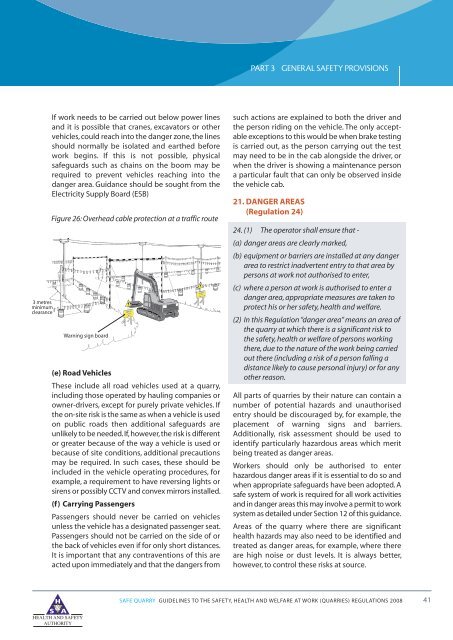Safe Quarry - Health and Safety Authority
Safe Quarry - Health and Safety Authority
Safe Quarry - Health and Safety Authority
Create successful ePaper yourself
Turn your PDF publications into a flip-book with our unique Google optimized e-Paper software.
PART 3<br />
GENERAL SAFETY PROVISIONS<br />
3 metres<br />
minimum<br />
clearance<br />
If work needs to be carried out below power lines<br />
<strong>and</strong> it is possible that cranes, excavators or other<br />
vehicles, could reach into the danger zone, the lines<br />
should normally be isolated <strong>and</strong> earthed before<br />
work begins. If this is not possible, physical<br />
safeguards such as chains on the boom may be<br />
required to prevent vehicles reaching into the<br />
danger area. Guidance should be sought from the<br />
Electricity Supply Board (ESB)<br />
Figure 26: Overhead cable protection at a traffic route<br />
Warning sign board<br />
(e) Road Vehicles<br />
These include all road vehicles used at a quarry,<br />
including those operated by hauling companies or<br />
owner-drivers, except for purely private vehicles. If<br />
the on-site risk is the same as when a vehicle is used<br />
on public roads then additional safeguards are<br />
unlikely to be needed.If,however,the risk is different<br />
or greater because of the way a vehicle is used or<br />
because of site conditions, additional precautions<br />
may be required. In such cases, these should be<br />
included in the vehicle operating procedures, for<br />
example, a requirement to have reversing lights or<br />
sirens or possibly CCTV <strong>and</strong> convex mirrors installed.<br />
(f) Carrying Passengers<br />
Passengers should never be carried on vehicles<br />
unless the vehicle has a designated passenger seat.<br />
Passengers should not be carried on the side of or<br />
the back of vehicles even if for only short distances.<br />
It is important that any contraventions of this are<br />
acted upon immediately <strong>and</strong> that the dangers from<br />
such actions are explained to both the driver <strong>and</strong><br />
the person riding on the vehicle. The only acceptable<br />
exceptions to this would be when brake testing<br />
is carried out, as the person carrying out the test<br />
may need to be in the cab alongside the driver, or<br />
when the driver is showing a maintenance person<br />
a particular fault that can only be observed inside<br />
the vehicle cab.<br />
21. DANGER AREAS<br />
(Regulation 24)<br />
24. (1) The operator shall ensure that -<br />
(a) danger areas are clearly marked,<br />
(b) equipment or barriers are installed at any danger<br />
area to restrict inadvertent entry to that area by<br />
persons at work not authorised to enter,<br />
(c) where a person at work is authorised to enter a<br />
danger area, appropriate measures are taken to<br />
protect his or her safety, health <strong>and</strong> welfare.<br />
(2) In this Regulation “danger area” means an area of<br />
the quarry at which there is a significant risk to<br />
the safety, health or welfare of persons working<br />
there, due to the nature of the work being carried<br />
out there (including a risk of a person falling a<br />
distance likely to cause personal injury) or for any<br />
other reason.<br />
All parts of quarries by their nature can contain a<br />
number of potential hazards <strong>and</strong> unauthorised<br />
entry should be discouraged by, for example, the<br />
placement of warning signs <strong>and</strong> barriers.<br />
Additionally, risk assessment should be used to<br />
identify particularly hazardous areas which merit<br />
being treated as danger areas.<br />
Workers should only be authorised to enter<br />
hazardous danger areas if it is essential to do so <strong>and</strong><br />
when appropriate safeguards have been adopted. A<br />
safe system of work is required for all work activities<br />
<strong>and</strong> in danger areas this may involve a permit to work<br />
system as detailed under Section 12 of this guidance.<br />
Areas of the quarry where there are significant<br />
health hazards may also need to be identified <strong>and</strong><br />
treated as danger areas, for example, where there<br />
are high noise or dust levels. It is always better,<br />
however, to control these risks at source.<br />
SAFE QUARRY GUIDELINES TO THE SAFETY, HEALTH AND WELFARE AT WORK (QUARRIES) REGULATIONS 2008 41
















